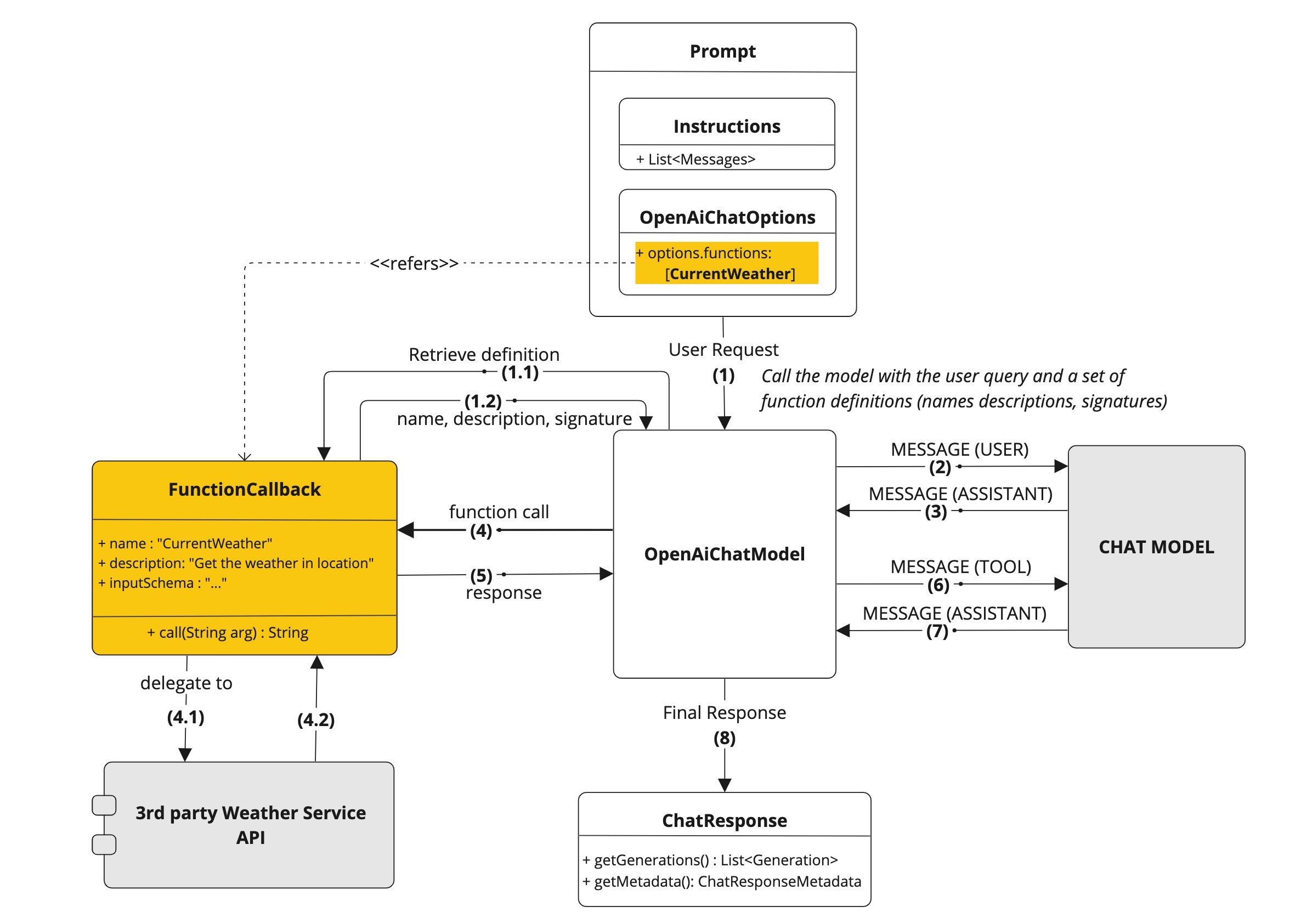函数调用
| 本页介绍了函数调用 API 的先前版本,该版本已弃用并标记为在下一版本中删除。当前版本可在 Tool Calling 中找到。有关更多信息,请参阅迁移指南。 |
您可以使用OpenAiChatModel并让 OpenAI 模型智能地选择输出包含参数的 JSON 对象,以调用一个或多个已注册的函数。
这允许您将 LLM 功能与外部工具和 API 连接起来。
OpenAI 模型经过训练,可以检测何时应该调用函数,并使用符合函数签名的 JSON 进行响应。
OpenAI API 不直接调用该函数;相反,该模型会生成 JSON,您可以使用该 JSON 在代码中调用函数,并将结果返回给模型以完成对话。
Spring AI 提供了灵活且用户友好的方法来注册和调用自定义函数。
通常,自定义函数需要提供一个函数name,description和函数调用signature(作为 JSON 架构)让模型知道函数需要哪些参数。这description帮助模型了解何时调用函数。
作为开发人员,您需要实现一个函数,该函数采用从 AI 模型发送的函数调用参数,并将结果返回给模型。您的函数可以反过来调用其他第三方服务来提供结果。
Spring AI 使这就像定义@Bean定义,该定义返回一个java.util.Function并在调用ChatModel.
在后台, Spring 使用适当的适配器代码包装您的 POJO(函数),以便与 AI 模型进行交互,从而避免编写繁琐的样板代码。 底层基础架构的基础是 ToolCallback.java 接口和配套的 Builder 实用程序类,以简化 Java 回调函数的实现和注册。
运作方式
假设我们希望 AI 模型使用它没有的信息进行响应,例如,给定位置的当前温度。
我们可以为 AI 模型提供有关我们自己的函数的元数据,它可以在处理您的提示时使用这些元数据来检索该信息。
例如,如果在处理提示期间,AI 模型确定它需要有关给定位置温度的其他信息,它将启动服务器端生成的请求/响应交互。AI 模型调用客户端函数。 AI 模型以 JSON 格式提供方法调用详细信息,客户端负责执行该函数并返回响应。
模型-客户端交互在 Spring AI 函数调用流程图中进行了说明。
Spring AI 大大简化了您需要编写以支持函数调用的代码。
它为您代理函数调用对话。
您可以简单地将函数定义作为@Bean,然后在提示选项中提供函数的 Bean 名称。
您还可以在提示符中引用多个函数 Bean 名称。
快速开始
让我们创建一个聊天机器人,通过调用我们自己的函数来回答问题。 为了支持聊天机器人的响应,我们将注册自己的函数,该函数获取一个位置并返回该位置的当前天气。
当模型需要回答诸如"What’s the weather like in Boston?"AI 模型将调用客户端,提供 location 值作为要传递给函数的参数。这种类似 RPC 的数据以 JSON 形式传递。
我们的函数调用一些基于 SaaS 的天气服务 API,并将天气响应返回给模型以完成对话。在此示例中,我们将使用一个名为MockWeatherService对不同位置的温度进行硬编码。
以下内容MockWeatherService.java表示天气服务 API:
public class MockWeatherService implements Function<Request, Response> {
public enum Unit { C, F }
public record Request(String location, Unit unit) {}
public record Response(double temp, Unit unit) {}
public Response apply(Request request) {
return new Response(30.0, Unit.C);
}
}将函数注册为 Bean
使用 OpenAiChatModel 自动配置,您可以通过多种方式在 Spring 上下文中将自定义函数注册为 bean。
我们首先介绍对 POJO 最友好的选项。
普通 Java 函数
在此方法中,您将定义一个@Bean就像你对待任何其他 Spring 托管对象一样。
在内部,Spring AIChatModel将创建一个ToolCallback这增加了通过 AI 模型调用它的逻辑。
的名称@Bean作为ChatOption.
@Configuration
static class Config {
@Bean
@Description("Get the weather in location") // function description
public Function<MockWeatherService.Request, MockWeatherService.Response> currentWeather() {
return new MockWeatherService();
}
}这@Descriptionannotation 是可选的,它提供了一个函数描述,可帮助模型了解何时调用该函数。这是一个重要的属性,可帮助 AI 模型确定要调用的客户端函数。
提供函数描述的另一种方法是使用@JsonClassDescription注解MockWeatherService.Request:
@Configuration
static class Config {
@Bean
public Function<Request, Response> currentWeather() { // bean name as function name
return new MockWeatherService();
}
}
@JsonClassDescription("Get the weather in location") // // function description
public record Request(String location, Unit unit) {}最佳实践是使用信息对请求对象进行注释,以便为该函数生成的 JSON 架构尽可能具有描述性,以帮助 AI 模型选择要调用的正确函数。
FunctionToolCallback 包装器
注册函数的另一种方法是创建一个toolCallback喜欢这个:
@Configuration
static class Config {
@Bean
public FunctionToolCallback weatherFunctionInfo() {
return FunctionToolCallback.builder("CurrentWeather", new MockWeatherService()) // (1) function name and instance
.description("Get the weather in location") // (2) function description
.inputType(MockWeatherService.Request.class) // (3) function input type
.build();
}
}它包装了第三方MockWeatherService函数并将其注册为CurrentWeather函数替换为OpenAiChatModel.
它还提供用于为函数调用生成 JSON 架构的描述 (2) 和输入类型 (3)。
| 默认情况下,响应转换器执行 Response 对象的 JSON 序列化。 |
这FunctionToolCallback内部根据MockWeatherService.Request类。 |
在 Chat Options 中指定函数
要让模型知道并调用您的CurrentWeather函数,以便在提示请求中启用它:
OpenAiChatModel chatModel = ...
UserMessage userMessage = new UserMessage("What's the weather like in San Francisco, Tokyo, and Paris?");
ChatResponse response = this.chatModel.call(new Prompt(this.userMessage,
OpenAiChatOptions.builder().tools("CurrentWeather").build())); // Enable the function
logger.info("Response: {}", response);上述用户问题将触发对CurrentWeather函数(每个城市一个),最终响应将如下所示:
Here is the current weather for the requested cities: - San Francisco, CA: 30.0°C - Tokyo, Japan: 10.0°C - Paris, France: 15.0°C
OpenAiFunctionCallbackIT.java 测试演示了此方法。
使用提示选项注册/调用函数
除了自动配置之外,您还可以使用Prompt请求:
OpenAiChatModel chatModel = ...
UserMessage userMessage = new UserMessage("What's the weather like in San Francisco, Tokyo, and Paris?");
var promptOptions = OpenAiChatOptions.builder()
.toolCallbacks(List.of(FunctionToolCallback.builder("CurrentWeather", new MockWeatherService()) // (1) function name and instance
.description("Get the weather in location") // (2) function description
.inputType(MockWeatherService.Request.class) // (3) function input type
.build())) // function code
.build();
ChatResponse response = this.chatModel.call(new Prompt(this.userMessage, this.promptOptions));| 默认情况下,在此请求的持续时间内启用提示内注册的函数。 |
这种方法允许根据用户输入动态选择要调用的不同函数。
FunctionCallbackInPromptIT.java 集成测试提供了一个完整的示例,说明如何使用OpenAiChatModel并在提示请求中使用它。
工具上下文支持
Spring AI 现在支持通过工具上下文将额外的上下文信息传递给函数回调。此功能允许您提供可在函数执行中使用的额外数据,从而增强函数调用的灵活性和能力。
作为java.util.BiFunction.这ToolContextcontains 作为不可变的Map<String,Object>允许您访问键值对。
如何使用工具上下文
您可以在构建聊天选项时设置工具上下文,并将 BiFunction 用于回调:
BiFunction<MockWeatherService.Request, ToolContext, MockWeatherService.Response> weatherFunction =
(request, toolContext) -> {
String sessionId = (String) toolContext.getContext().get("sessionId");
String userId = (String) toolContext.getContext().get("userId");
// Use sessionId and userId in your function logic
double temperature = 0;
if (request.location().contains("Paris")) {
temperature = 15;
}
else if (request.location().contains("Tokyo")) {
temperature = 10;
}
else if (request.location().contains("San Francisco")) {
temperature = 30;
}
return new MockWeatherService.Response(temperature, 15, 20, 2, 53, 45, MockWeatherService.Unit.C);
};
OpenAiChatOptions options = OpenAiChatOptions.builder()
.model(OpenAiApi.ChatModel.GPT_4_O.getValue())
.toolCallbacks(List.of(FunctionToolCallback.builder("getCurrentWeather", this.weatherFunction)
.description("Get the weather in location")
.inputType(MockWeatherService.Request.class)
.build()))
.toolContext(Map.of("sessionId", "123", "userId", "user456"))
.build();在此示例中,weatherFunction定义为将请求和工具上下文作为参数的 BiFunction。这允许您直接在函数 logic中访问上下文。
然后,您可以在调用聊天模型时使用以下选项:
UserMessage userMessage = new UserMessage("What's the weather like in San Francisco, Tokyo, and Paris?");
ChatResponse response = chatModel.call(new Prompt(List.of(this.userMessage), options));这种方法允许您将特定于会话或用户的信息传递给您的函数,从而实现更多上下文和个性化的响应。
附录:
OpenAI API 函数调用流程
下图说明了 OpenAI API 函数调用的流程:
OpenAiApiToolFunctionCallIT.java 提供了有关如何使用 OpenAI API 函数调用的完整示例。 它基于 OpenAI 函数调用教程。

